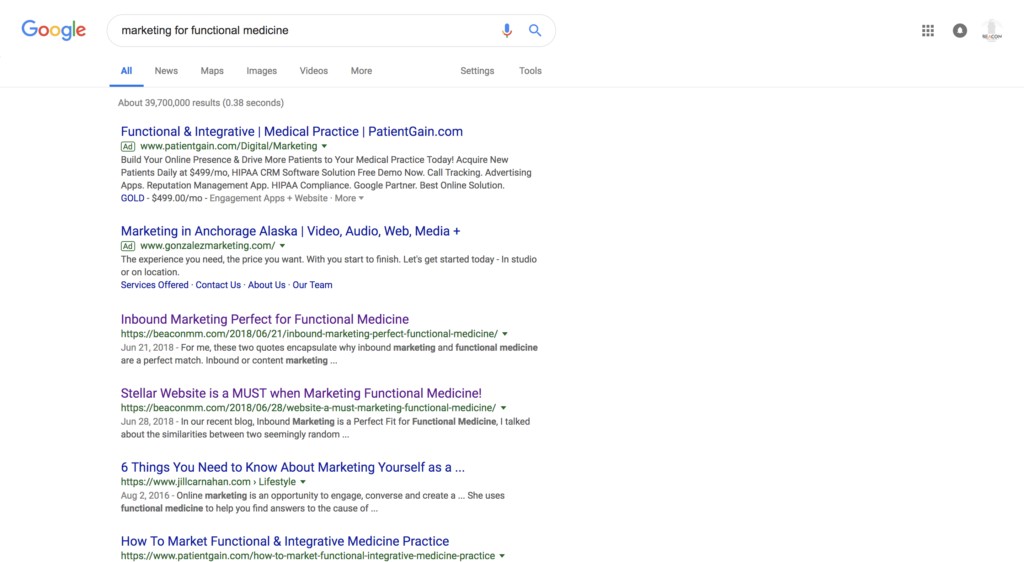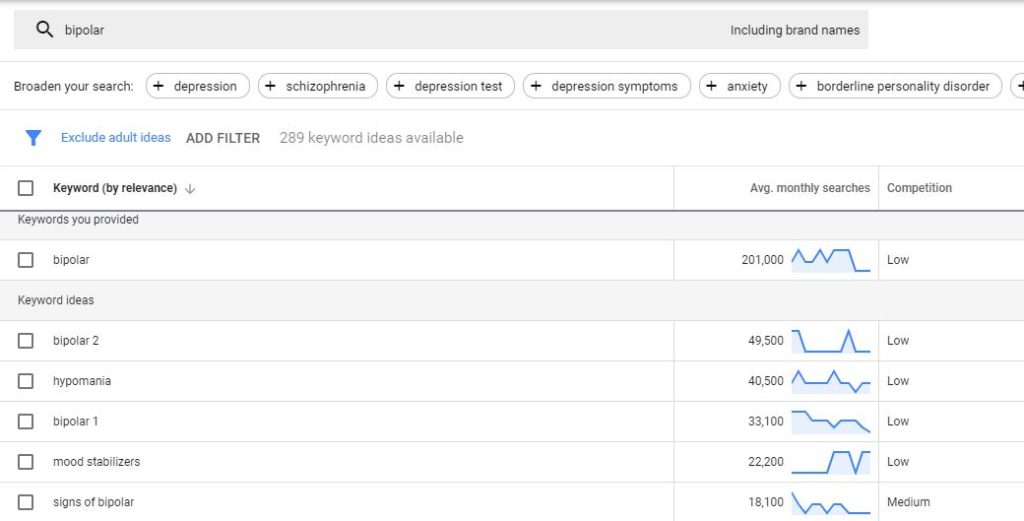“The biggest mistake I see, is that people tend to give up…SEO (blogging) is a lifestyle, it’s a practice, it’s not a transaction…You just gotta keep going, you’re building your castle, you’re building your moat, it’s going to take time.”
Have you ever considered publishing a blog for your mental health clinic?
Maybe you thought about using a blog to provide helpful resources to your patients such as mindfulness exercises or relaxation techniques.
Or maybe you wanted to update your patients on uplifting and positive events happening around town.
Whatever the case may be, a blog is a powerful marketing tool and something you should absolutely consider investing in if you are looking to grow your mental health practice…
…but there is a particular way to go about doing it.
We have seen incredible results from blog marketing in terms of new business both for us and for our clients.
But our success stems from a particular philosophy of blog marketing that we use, as well as a few, key tactics.
Without this approach, our blogs would be just that…blogs…sitting out there in the abyss of the internet with no one to read them.
In order to keep you from publishing your mental health blogs to the internet abyss, we are going to share our approach with you today!
It’s the approach that gets the results from blog marketing that all clinic managers crave.
So let’s hop to it and get you started on strategically blog marketing for your mental health clinic–to get results!
Why Blog Marketing in the First Place?
Remember those incredible results we were talking about?
Let’s cover just a few of them, shall we?
Here are some recent case studies of effective blog marketing for great results.
Case Study #1: The Beacon Blog
Beacon (that’s us!) recently decided that we want to be working with functional medicine as an industry.
So we did what we do best: We blogged!
We started writing blogs on all kinds of topics related to our services using “functional medicine” as a keyword (we’ll talk about keyword-optimization in a moment).
Lo and behold, within a few months, we were in the #1 and #2 slots on Google for the search, “marketing for functional medicine!”

Now you could attribute something like this to fate OR you could look at the facts:
- We were writing blogs at the recommended length according to search engine optimization (SEO) best practices (we’ll talk about SEO in a moment too).
- We were strategically targeting keywords like “functional medicine,” “marketing,” and “inbound marketing.”
- We were making sure all the technical optimizations were in place on our website (such as mobile-friendliness, fast-loading pages, and metadata).
All of these factors contributed to the fantastic ranking we achieved.
But that wasn’t even the result that mattered!
Because of the ranking, we began to receive qualified leads for our services from functional medicine practices through our website.
These two blogs published just two weeks apart in June of 2018 are now a significant part of our sales funnel for functional medicine.
Let’s take a look at another example of effective blog marketing.
Case Study #2: The Mandanas Dental Blog
A few years back, one of our longest-standing clients, Dr. Mandanas, decided that she wanted to pivot her dental practice to focus on integrative dentistry.
So we made quick work of it and started blog marketing on the topic!
Once again, we used the appropriate keywords and once again, we were ranking on the first page of Google for the search:

Using the same practices we used for Beacon, we were able to achieve incredible results for this client in a short timeframe.
Dr. Mandanas never runs out of work at her practice.
We were very happy to accomplish something like this for her using a little philosophy called inbound blog marketing.
How to Make Blog Marketing Work for Your Mental Health Clinic
How do you make blog marketing work for your mental health clinic?
By taking the inbound philosophy of blog marketing to heart.
It is this philosophy that will not only encourage potential mental health patients to click on your blog, but also to read it all the way through.
The Inbound Philosophy of Blog Marketing
The inbound philosophy of blog marketing is simple.
It’s the idea that people are searching the internet for something of value and if we consistently provide relevant value to them, they are going to think of us as the experts and prefer us over others when they’re ready to take action on their searches.
“People are searching the internet for something of value and if we consistently provide relevant value to them, they are going to think of us as the experts and prefer us over others when they’re ready to take action on their searches.”
What that means for you, a mental health practice, is that they register as a new patient at your clinic instead of your competitor’s when they’re ready to start services.
Patient preference is as good as gold but it’s so easy to earn through inbound blog marketing!
Here’s how you do it.
Research and find exactly what value your potential new patients are searching for…
…then write blogs on those topics.
Patient searches for value typically come in the form of a question.
Answering Mental Health Questions
We have a few tools up our sleeve for researching patient questions.
The first is the king of search’s (that’s Google) own tool for discovering popular searches, Google AdWords Keyword Planner!
Start by choosing a mental health topic that relates to your services AND you may want to blog about such as “bipolar,” then enter that topic into the tool.

What you will find is that there are many different ways people search about bipolar.
Pick one that meets four criteria:
- Has a high number of average monthly searches (all of the examples provided above are high).
- Has a low to medium competition level.
- Is something that relates to your services.
- Is something that you may want to blog about.
For this example, we’ll pick “hypomania.”
The next thing you’ll do is enter this popularly searched phrase (better known as a keyword) into a second tool called AnswerthePublic.
What this tool gives you is commonly searched questions that use your keyword:

If you can read up, down, and sideways (sorry, we didn’t create this tool), then you’ll be able to pick a commonly searched patient question that you could write something about.
Perhaps you’ll choose something like:
- How long does hypomania last?
- Can hypomania turn into mania?
- What is hypomania?
By writing a blog that answers one of these questions, you are going to capture potential patients who think they may be experiencing hypomania and are asking questions through Google searches.
Chances are, these people could use the services you provide and may elect to register with your clinic when they’re ready to get help.
One important thing to note, however, is that they’re not going to see your blogs unless they rank on Google within the first several slots.
That’s where a few, key tactics come in.
The approach that we’re sharing with you today sits at the intersection of the inbound philosophy of blog marketing and these tactics.
Key Tactics for Blog Marketing in the Mental Health Industry
How do you get a blog to rank, anyway?
We do three things that have contributed to our success in blog marketing.
These tactics work for all industries including mental health.
1. Make Your Mental Health Topic Less Competitive
The first thing we do is make our topic less competitive.
Here’s what we mean by that.
There are approximately 40,000 searches about “hypomania” conducted per month.
Your competition–and even organizations who are not competing with you, such as national mental health sites–are probably trying to capture some of this traffic.
For example, there are currently (as of the date of this blog post) 619,000 results for “What is hypomania?”
The trick is to make that number as low as possible so you stand a chance of ranking.
You can make the competition for your topic low by modifying it to target a particular niche.
Maybe you specialize in working with adolescents.
The search, “What is hypomania in teens?” has just 85,600 results.
That may still feel like a high number, but it is significantly low as far as search results for popularly searched phrases are concerned.
You actually have a very good chance of ranking for a search like this; the results currently all have to do with “bipolar” and not “hypomania” specifically.
We ranked our “marketing for functional medicine” against 62,300,000 results.
How about that?!
2. Use Blog Marketing Best Practices
The second thing we do is make sure we are following the latest best practices for blog marketing.
Many of these have to do with keyword optimization and search engine optimization (SEO).
Search engine optimization (SEO) is making your blog as Google-friendly as possible so that it again, stands the chance of ranking.
Much of this is accomplished through keyword optimization of your blog.
Keyword optimization is taking your identified keyword (in our case, “hypomania”) and including it throughout the blog so Google knows what you’re talking about and again, knows what you want to rank for.
Here is our internal blog marketing checklist:
- Word count should be at least 400-600 for some markets and 1,200-1,600 for extra competitive markets
- Blog should include an intro, body, and conclusion
- Keyword should be in the first sentence and approximately 3% of the blog
- Keyword should be in as many headers as possible without keyword stuffing
- There should be 1-3 relevant links throughout, whether outbound links or links to other pages/posts on the company website
- There should be a call-to-action (CTA) in the last paragraph linking to another page on the website, such as Contact Us
- Spelling and grammar should be checked with Grammarly
In addition to these things, you should check the quality of your blog title with a title scoring tool such as CoSchedule’s Headline Analyzer.
A score of 70 or above is preferable.
Finally, your website, in general, should be SEO-friendly, meaning, mobile-friendly and fast-loading without broken links and pages.
That’s a topic for another blog, but suffice it to say, an SEO-friendly website will have a place for you to set your blog’s metadata.
This is the title, URL, description, and keyword for your blog as they will display on the Google results page.
It is very important that you have these items completed with your keyword and also that your keyword is in the alt tag of all images in your blog.
Pro Tip: WordPress is the most SEO-friendly website platform available and it integrates with easy-to-use SEO plugins such as SEOPress.
3. Try the Waterfall Method of Blogging
If you have any background or knowledge of SEO, you will also understand the importance of links.
The best thing for a new blog trying to rank is what’s called an “inbound link,” or, another blog linking to your blog from a credible and authoritative website.
Quality inbound links can be extremely hard to come by, so we go about showing Google authority in another way (in addition to inbound links, if we can get them).
We create an authority structure within our own website!
We call it a “waterfall structure” because it looks like a descending waterfall.
Before we try to explain, here is the waterfall blog structure you are currently in for your frame of reference. 😉
- Blog about Digital Marketing for Mental Health
- Blog about Mental Health Brands
- Logo Design
- Graphic Design
- Blog about Website Design for Mental Health
- Landing Pages
- Website Hosting
- Blog about Social Media for Mental Health
- Blog about Google Advertising for Mental Health
- Blog about Blog Marketing for Mental Health – THIS BLOG!
- Blog about Video Production for Mental Health
- Blog about Mental Health Brands
The idea here is to address the topics from the blogs at the bottom of the waterfall in the blogs at the top of the waterfall.
Then, once the blogs at the bottom of the waterfall have been written and published, you go back to the blogs at the top of the waterfall, and link the sections discussing the topics from the bottom of the waterfall to those newly published blogs!
It’s a little confusing at first, but once you get the hang of it, it’s a killer blog marketing strategy.
What you’re doing is linking one blog to another using the keyword the second blog is targeting as hyperlinked text.
This shows Google exactly how your blogs relate to each other and which ones have the most authority.
Alright, friend!
That’s all we have for you today.
We hope this outline of our unique (and effective) blog marketing approach helps you get the results for your mental health clinic you’ve been looking for.
On the other hand, if you are interested in hiring our team to accomplish this for you, we would love to talk.
We’ve been blog marketing for results in a wide variety of industries for many years and we seriously enjoy helping our clients make it happen.
You can schedule a free consultation with us easily and painlessly using our live scheduler.
For those DIY mental health clinic managers, we wish you the best as you begin your blog marketing journey!
Happy marketing to all!





